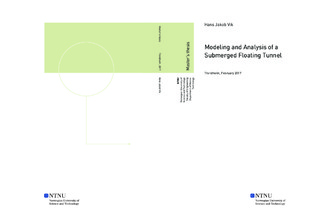| dc.description.abstract | This master thesis is a study of a submerged floating tunnel and its responses exposed to hydrodynamic loading. Static, modal and dynamic analyses have been performed in ANSYS Mechanical 16.2 for the a global bridge model.
First, a literature study of existing and planed marine bridges was included. It focuses on the differences and similarities for marine bridge concepts, emphasizing bridges planed for a ferry-free E39. A submerged floating tunnel, like the bridge modeled in this thesis, has never been built before.
A study of pontoon configurations focuses on the differences between two pontoon geometries. The restoring and damping coefficients from the analysis results are implemented in the global submerged floating bridge model. A comparison of pontoon behavior is also used to verify the hydrodynamic modeling in ANSYS. The comparison is carried out by modeling the same pontoon in two different softwares, Wadam and ANSYS, and comparing motion and behavior. The results are good, but uncertainties connected to added mass and boundary condition modeling, effects the results. The challenges with correct boundary conditions are not present in the global model, and the results are therefore deemed good for further analyses.
The static analysis results, focusing on a neutrally buoyant structure, has a maximum displacement of 0.24 meters and a minimum displacement of -0.17 meters. These results are considered good and the structure is concluded neutrally buoyant.
The eigenfrequencies from the eigenfrequency analysis coincide with the frequencies from a compared study conducted by the Reinertsen Olav Olsen Group, for the same submerged floating tunnel The mean deviation for the 25 first eigenfrequencies is 6.4 %, with a maximum of 19 % and a minimum of 1.3 %. The eigenperiods from mode 25 to 1 range from 5.1 - 45.1 seconds and the mode shapes of the first 10 modes coincide with the ones from the compared study.
The thesis includes multiple dynamic analyses with different wave loading. The maximum harmonic wave loading is estimated from the the irregular significant wave height and period of 2.14 meters and 4.8 seconds. The final harmonic wave, causing maximum harmonic bridge response, has a height of 4.85 meters and a period of 6.75 seconds.
A 300 seconds long irregular wave analysis is carried out in order to estimate the maximum irregular bridge response. The analysis was supposed to be 3 hours long, but due to memory limitations, the maximum length was 300 seconds. The most probable and maximum expected irregular responses for a 3-hour sea state are estimated from the 300 seconds long irregular analysis, in order to compare the results with the maximum harmonic wave responses. While maximum bending moments about global Y- and Z-axis and minimum bending moment about Z-axis occur for the harmonic maximum wave loading, the rest occur for the estimated 3-hour irregular wave response.
The maximum and minimum bending moments about global Y-axis are 939 and -1028 MNm. The location for the extremes are in the main tunnels of the bridge at the biggest spans between supports. The biggest spans are at the center or at the ends of the bridge. The maximum and minimum torsional moments about global X-axis occur in the main tunnels at the supports closest to the largest spans. It has an absolute value of 931.4 MNm. For the bending moments about global Z-axis, the values are 301 and -356 MNm. These moments are situated at the main tunnels where shafts connect the pontoons to the tunnels.
The maximum displacement for the harmonic analysis is 1.11 meters, while the estimated expected maximum for the irregular analysis is 1.85 meters. This is reflected in the maximum von Mises stress, which is 44 MPa for the harmonic analysis and 164 MPa for the estimated irregular expected maximum.
The maximum responses from the regular and irregular analysis are good compared to each other. The fact that the characteristics of the regular wave is estimated from the irregular spectrum parameters, implies that similar magnitudes, directions and locations for the responses are to be expected. The differences in the response values have its origin from the harmonic and irregular wave loading. The wave loading causes different bridge motions, which eventually results in different response magnitudes.
The overall results for the analyses carried out are considered reasonable and accurate. Further modeling and analyses can be performed in order to verify the results in more detail. | |

